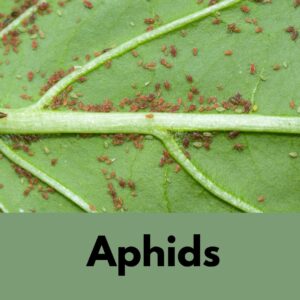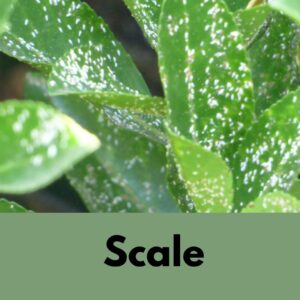Since the vast majority of houseplants are actually tropical plants, they need to be moved indoors once the night temperatures regularly begin falling below the 50’s.
- Inspect your plants. Look at the leaf/stem junctions, the stems, and the tops and bottoms of the leaves. You are looking for anything that looks out of place such as white fuzzy things called mealybugs, black spots, mildew, aphids, or other pests. Gently distrub the soil and check for any ants or other bugs. If you notice something in particular and don’t know what it is – do a quick internet search or contact us! See photos below for the common houseplant pests.
- Treat your plants. Even if you don’t see any visible pests, it’s not a bad idea to use a systemic granule insecticide for longer term protection. You don’t want to bring any new pests indoors to any other houseplants.
- Tidy up your plants. Remove dead or yellowing leaves or stems. Trim back your vining plants to the shape/length you desire.
- Shower your plants. A good rinse off with a water hose on a warm day will help water in your insecitcide granules and clean off dust and debris. You can also do this indoors in the shower if you prefer.
- Move your plants. If possible, you can acclimate your houseplants to coming indoors by brining them in at night and then placing them back outside during the day. Slowly decrease the time they spend outside during the day for a couple weeks. (only if the daytime temperatures are above 60 degrees)
Winter certainly makes our air much drier and most houseplants thrived in the humid atmosphere outside this summer so don’t forget to provide them with a little extra humidity once they are indoors. Some houseplants won’t require any additional humdity such as succulents, cactus, & Ponytail Palms. There are several ways to provide humidity:
- Certain varieties that like high humidity such as Calathea can be brought into a more humid room such as a bathroom
- Keep plants grouped together
- Run a small humidifier
- Make your own pebble try simply by placing small rocks/pebbles in a saucer and setting the plant on top. When you put water in the saucer it will evaporate near the plant increasing humidity. Make sure to keep your pot on top of the pebbles so it doesn’t not soak up water through the drainge hole and become overwatered.
A few other tidbits on caring for your houseplants during the winter:
- Avoid fertilizing as this time of year is kind of like a houseplant siesta. Like bears – but not fuzzy.
- Make sure the windows are freshly cleaned in any room containing houseplants. This allows more light to come through.
- Water less often that you did during the Spring & Summer.
- When you water, make sure you water thoroughly so water runs out of the drainage holes. Empty any saucers after a couple hours if they are still holding water.
- Don’t worry if you experience a small amount of leaf drop. It’s normal. If the leaf drop becomes excessive then give us a call or bring your plant in to see us. Ficus are notorious drama queens so they may drop A LOT of leaves. It’s how they cope.
- large leaf plants like Fiddle Leaf fig can be wiped down with a damp cloth
Did you know we have care sheets for houseplant on our website? We are working to update and include as many as possible! You can see our current list of care sheets here.




